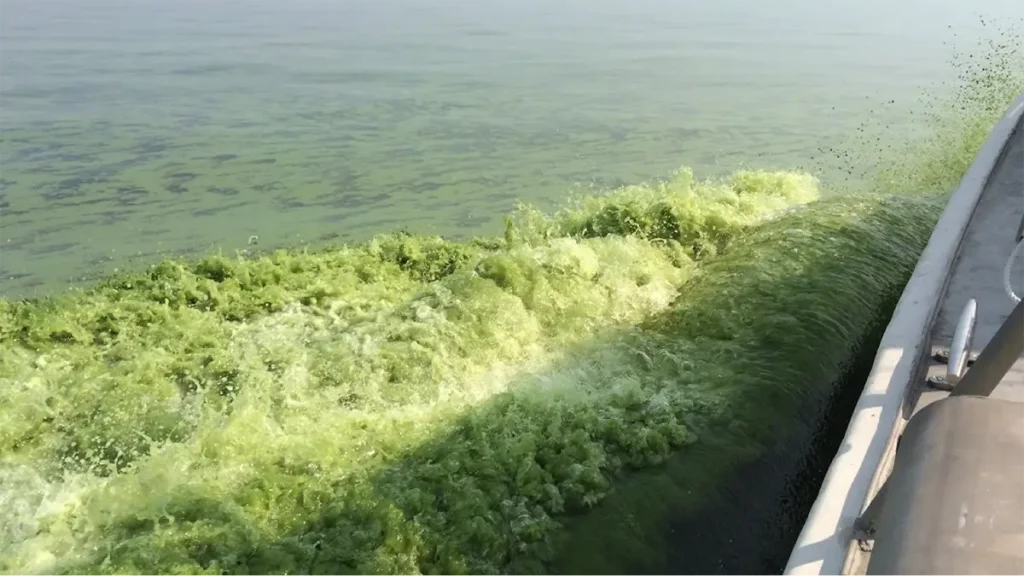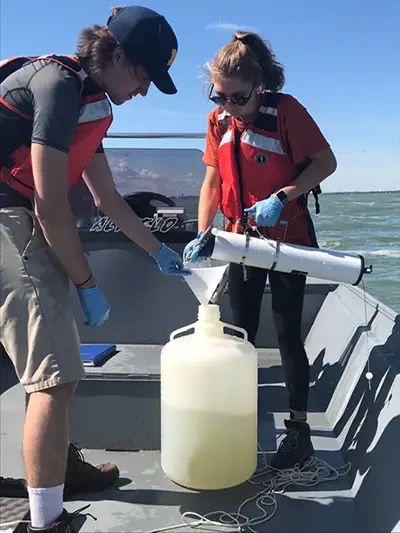UT Faculty Join New $6.5 Million Grant to Study Climate Links Between Algal Blooms and Human Health

by Randall Brown
Britney Zepernick, a post-doctoral researcher in the UT Department of Microbiology, recently published related research on diatom blooms in Lake Erie.
Faculty in the University of Tennessee Department of Microbiology are part of a new $6.5 million, five-year federal grant to establish a virtual center for the study of links between climate change, harmful algal blooms, and human health.
Increased precipitation, more powerful storms, and warming Great Lakes waters all encourage the proliferation of harmful algal blooms composed of cyanobacteria, also known as blue-green algae. These microorganisms can produce toxins harmful to humans, pets, and wildlife.
Though the pea-green summer blooms in western Lake Erie are the best-known in the region, cyanobacterial harmful algal blooms, or cHABs, now occur in all five Great Lakes and in fresh waters around the US. These blooms can increase water-treatment costs for local governments and harm vital summer economies in communities that enjoying fishing, swimming, and boating. In the Knoxville area earlier this year, a cHAB of Planktothrix rubescens (“pink algae”) in Meads Quarry at Ijams Nature Center closed swimming and other activity for a month.

“The University of Tennessee has a 25-plus year history of contributing to research on the security of our water supplies with respect to harmful algal blooms, with the Great Lakes being a major focus,” noted Steven Wilhelm, the Kenneth and Blaire Mossman Professor of Microbiology and one of the project’s leaders.
The UT team, including Wilhelm and David Talmy, assistant professor in the Department of Microbiology, will focus on the effects of a changing climate and identify new players in the biological problems the lake is having. To understand the drivers of toxic algal bloom events, they previously collaborated with researchers in Michigan and Berlin, Germany, on the development of mathematical models that predict toxin production by cells, and how some of the proposed abatement methods may have unintended consequences.
Understanding best abatement practices and projecting the long-term effects of a changing climate—as well as the disruptive storms that go with it—are a major goal of this research. Participants will work across four collective projects to enable an assessment of the human health risks of cHAB toxins. These complementary projects seek to determine how climate change affects cHABs and how cHABs impact human health.
This virtual center was founded at Bowling Green State University in 2018 with funding from the National Institutes of Health and the National Science Foundation. Following the retirement of founding director Professor George Bullerjahn at BGSU, the center’s administrative home moved to Ann Arbor with renewed funding from the two federal agencies under the directorship of University of Michigan (UM) Professor Gregory Dick.
The center maintains core projects as it evolves to pursue new directions informed by more than 70 research papers published in peer-reviewed scientific journals by center-funded scientists since 2018. In addition, center-funded researchers will develop new technologies for advanced monitoring and forecasting of cyanobacterial harmful algal blooms in collaboration with colleagues at NOAA’s Great Lakes Environmental Research laboratory and the U-M-based Cooperative Institute for Great Lakes Research.
“The threat to water resources in the Great Lakes—which hold about 95% of the surface fresh water in the US and support a multibillion-dollar blue economy—is real,” said Dick. “But despite these serious threats, key scientific questions surrounding the climate drivers and health impacts of cHABs remain unresolved. Our knowledge is not yet sufficient to predict how a changing climate will impact cHAB distributions, community composition, or toxicity.”
Studies will combine observation, experiment, and modeling in areas of lake science, climatology, microbiology, and biomedical science. A community engagement core led by The Ohio State University (OSU) will communicate findings to relevant communities and stakeholders.
In addition to UT, UM and OSU, partners include more than 28 faculty researchers and dozens of students at Bowling Green State University, the University of Toledo, Wayne State University, Michigan State University, University of North Carolina, James Madison University, the State University of New York, and the University of Windsor in Canada.